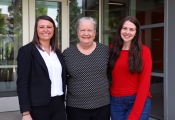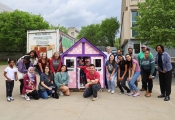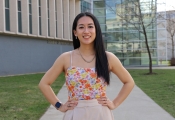Theatrical performance an opportunity for reflection on grief, love, praise and hope

Ambre Emory-Maier (left), Amy Fairchild and Dana Renga discuss the intersections between art and public health.
Time spent distanced from friends and family as the COVID-19 pandemic raged left an indelible mark. As our lives continue to shift to a new sense of normal, we have an opportunity to reflect on what we grieve, love, praise and hope for the future — and that was the purpose of a theatrical event co-hosted by the college last week.
Students, faculty and staff from across the university came together on April 28 for the event and a conversation to process the complex ways the pandemic changed our world. A performance of “What We Learned While Alone: Global Voices Speak to the Pandemic,” a Kent State University production, combined spoken word, music, movement and digital dialogue. Actors used the stage to express the challenges of distancing from loved ones and digital connection, and the relief and uncertainty surrounding vaccination.
Attendees were invited to reflect on their pandemic experiences and respond anonymously to a series of prompts using their phones. The responses, displayed on a screen, showed a universal desire for connection and grief about time lost with those who are no longer here. Audience submissions were transformed into a poem at the end of the 50-minute performance.

After the performance, College of Public Health Dean Amy Fairchild led a conversation about the intersections between art and public health with Dana Renga, dean of Arts and Humanities at the College of Arts and Sciences, which co-sponsored the event, and Ambre Emory-Maier, assistant professor of dance at Kent State University and the performance’s movement director.
“I was surprised how emotional I got,” Fairchild said. “This was my life for two years…so many people are still processing the experience. They are struggling with, who am I now?”
College students faced significant challenges throughout the pandemic, Emory-Maier said. The threat of illness, impact of isolation and uncertainty about the future have taken a toll on young people around the world.
“Public health is very much also involved with helping people manage their distress, to heal from this situation,” she said. “I feel like the body is such an important part of that process, and movement and dance can be involved with how we’re helping our students manage.”
The “What We Learned” performance debuted in October at the National Academy of Sciences.
Renga spoke about how the ways we consume art changed during the pandemic. While museums and galleries closed their doors, art “opened up to the world” in other ways, such as through balcony singing in Italy and more expansive digital museum collections.
Undergraduate students interested in the intersections between these themes can pursue a public health and the arts interdisciplinary minor.









